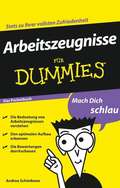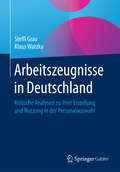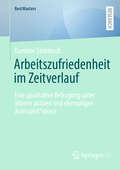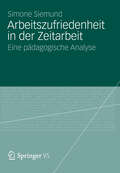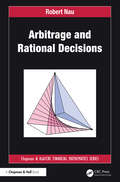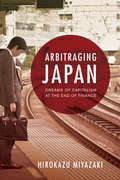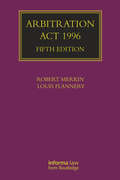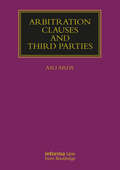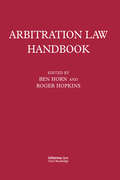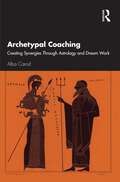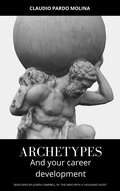- Table View
- List View
Arbeitszeugnisse für Dummies Das Pocketbuch (Für Dummies)
by Andrea Schimbeno"Stets pünktlich und adrett gekleidet." Was bedeutet das in einem Zeugnis? Andrea Schimbeno weiht Sie nicht nur in die Geheimsprache der Arbeitszeugnisse ein, Sie erklärt Ihnen auch, was ein "einfaches" von einem "qualifizierten" Zeugnis unterscheidet. Was darf drinstehen und was nicht? Was bedeutet die Forderung des Gesetzgebers, dass ein Arbeitszeugnis "wohlwollend" formuliert sein muss? Und welche Fristen müssen eingehalten werden? Ob Sie ein Arbeitszeugnis erhalten oder eines schreiben müssen - es gibt viel zu beachten. Hier erfahren Sie, worauf Sie achten müssen. Stimmt die Form? Wurden alle wichtigen Punkte berücksichtig? Als Arbeitnehmer begleitet Sie ein Arbeitszeugnis durch Ihr weiteres Berufsleben, als Arbeitgeber können Sie für falsche Angaben haftbar gemacht werden. Da lohnt es sich, sich schlau zu machen.
Arbeitszeugnisse in Deutschland: Kritische Analysen zu ihrer Erstellung und Nutzung in der Personalauswahl
by Klaus Watzka Steffi GrauDieses Werk bietet auf Basis einer kritischen Analyse der derzeitigen Zeugnispraxis aktuelle empirische Forschungsergebnisse zum Thema Arbeitszeugnisse. Sie zeigen dringenden Verbesserungsbedarf an. Die Autoren pr#65533;sentieren daher ein breites Spektrum konkreter und praxisnaher Handlungsempfehlungen f#65533;r Personalverantwortliche und Unternehmen sowie den Gesetzgeber. Ausf#65533;hrlich zeigen die Verfasser, wie die Qualit#65533;t und Pr#65533;zision und damit der Nutzen von Arbeitszeugnissen f#65533;r die Personalauswahl gesteigert werden kann.
Arbeitszufriedenheit im Zeitverlauf: Eine qualitative Befragung unter älteren aktiven und ehemaligen Journalist*innen (BestMasters)
by Karoline SteinbockIn einer sich wandelnden Medienwelt sind Fragen nach der Zufriedenheit mit der Arbeit und nach Veränderungen der Zufriedenheit im Laufe des Berufslebens von zentraler Bedeutung. Die Forschungsarbeit geht der Frage nach, wie sich die beruflichen Erwartungen, die Veränderungen in der Medienlandschaft und die individuellen Karriereentscheidungen auf die Zufriedenheit ausgewirkt haben. Durch problemzentrierte Interviews mit ehemaligen, aktiven und bereits pensionierten Journalist*innen bietet die Arbeit wertvolle Einblicke, wie sich die Arbeitszufriedenheit unter dem Einfluss von Faktoren wie der digitalen Transformation und der Medienkrise entwickelt. Darüber hinaus wird untersucht, welche weiteren Faktoren die Arbeitszufriedenheit beeinflusst haben. Diese Untersuchung liefert nicht nur praxisrelevante Erkenntnisse für das Personalmanagement und die Organisationsentwicklung in der Medienbranche, sondern bietet auch eine tiefgehende Reflexion über die Arbeitswelt von Journalist*innen in einem sich ständig wandelnden Umfeld.
Arbeitszufriedenheit in der Zeitarbeit: Eine pädagogische Analyse
by Simone SiemundWie empfinden Zeitarbeitskräfte ihre tägliche Arbeit? Welche Ziele verfolgen sie? Was macht sie trotz des hohen prekären Potenzials von Zeitarbeit zufrieden? In einer qualitativen Studie untersucht Simone Siemund Arbeitszufriedenheit und -motivation bei Zeitarbeitskräften. Die Autorin beschreibt Wirkungen prekärer Beschäftigungsverhältnisse und macht deutlich, welchen spezifischen Belastungen Beschäftigte in der Zeitarbeit ausgesetzt sind. Aufgrund des pädagogischen Blickwinkels rücken dabei die Erwerbsbiographien der befragten Personen ebenso in den Fokus wie berufliche Kompetenzentwicklung und Lernen. Zitate aus zahlreichen Interviews ermöglichen Einblicke in die Branche aus Sicht der Beschäftigten.
Arbitrage and Rational Decisions (Chapman and Hall/CRC Financial Mathematics Series)
by Robert NauThis unique book offers a new approach to the modeling of rational decision-making under conditions of uncertainty and strategic and competition interactions among agents. It presents a unified theory in which the most basic axiom of rationality is the principle of no-arbitrage, namely that neither an individual decision maker nor a small group of strategic competitors nor a large group of market participants should behave in such a way as to provide a riskless profit opportunity to an outside observer.Both those who work in the finance area and those who work in decision theory more broadly will be interested to find that basic tools from finance (arbitrage pricing and risk-neutral probabilities) have broader applications, including the modeling of subjective probability and expected utility, incomplete preferences, inseparable probabilities and utilities, nonexpected utility, ambiguity, noncooperative games, and social choice. Key results in all these areas can be derived from a single principle and essentially the same mathematics.A number of insights emerge from this approach. One is that the presence of money (or not) is hugely important for modeling decision behavior in quantitative terms and for dealing with issues of common knowledge of numerical parameters of a situation. Another is that beliefs (probabilities) do not need to be uniquely separated from tastes (utilities) for the modeling of phenomena such as aversion to uncertainty and ambiguity. Another over-arching issue is that probabilities and utilities are always to some extent indeterminate, but this does not create problems for the arbitrage-based theories.One of the book’s key contributions is to show how noncooperative game theory can be directly unified with Bayesian decision theory and financial market theory without introducing separate assumptions about strategic rationality. This leads to the conclusion that correlated equilibrium rather than Nash equilibrium is the fundamental solution concept.The book is written to be accessible to advanced undergraduates and graduate students, researchers in the field, and professionals.
Arbitrage in the Government Bond Market?
by Peter Tufano Michael E. EdlesonDocuments a pricing anomaly in the large and liquid treasury bond market. The prices of callable treasury bonds seem to be inconsistent with the prices of noncallable treasuries and an arbitrage opportunity appears to exist. Permits instructors to introduce the treasury market, the concept of creating synthetic instruments, principles of arbitrage, and institutional frictions in the bond markets.
Arbitrage: Strategies for Global Value Creation
by Pankaj GhemawatThis chapter focuses on arbitrage strategies that exploit selected differences across countries instead of treating them all as constraints, examining economic and labor arbitrage in particular. This chapter was originally published as chapter 6 of "Redefining Global Strategy: Crossing Borders in a World Where Differences Still Matter."
Arbitraging Japan: Dreams of Capitalism at the End of Finance
by Hirokazu MiyazakiFor many financial market professionals worldwide, the era of high finance is over. The times in which bankers and financiers were the primary movers and shakers of both economy and society have come to an abrupt halt. What has this shift meant for the future of capitalism? What has it meant for the future of the financial industry? What about the lives and careers of financial operators who were once driven by utopian visions of economic, social, and personal transformation? And what does it mean for critics of capitalism who have long predicted the end of financial institutions? Hirokazu Miyazaki answers these questions through a close examination of the careers and intellectual trajectories of a group of pioneering derivatives traders in Japan during the 1990s and 2000s.
Arbitration Act 1996: An Annotated Guide (Lloyd's Arbitration Law Library)
by Robert Merkin Louis FlanneryThis book is an essential resource for any legal practitioner involved in any aspect of English arbitration law. It provides a thorough annotation of the Arbitration Act 1996, and contains comprehensive explanations of developments in the relevant case law to each section of the Act.Since the fourth edition of this book, the English courts have decided many important new cases on virtually every aspect of arbitration law. The most important developments relate to: The growth of anti-arbitration injunctions; The use of freezing injunctions against third party assets and the availability of anti-suit injunctions in EU proceedings; The definition of seat, the appointment of arbitrators, choice of applicable law, jurisdiction, the form of the award and the slip rule; Enforcement of foreign awards, and challenges to domestic awards by way of jurisdictional attacks, serious irregularity or error of law In this 5th edition, the notes to each section contain helpful sub-headings and a new Appendix will contain a fully annotated version of CPR Part 62 and the Practice Direction. The book will also be useful for academics and university students of law at all levels seeking an understanding of the 1996 Act, including those on the Legal Practice Course.
Arbitration Clauses and Third Parties (Lloyd's Arbitration Law Library)
by Asli ArdaThis is the first book to focus on the legal question of the incorporation of arbitration clauses, even though this issue constitutes a common problem that arises frequently in practice. Arbitration Clauses and Third Parties compares different branches of law, namely shipping, reinsurance, and construction, where the legal notion of incorporation is often implemented. It evaluates how the differences and peculiarities of the said branches of law impact the outcome of the incorporation of arbitration clauses and therefore why a ‘one size fits all’ approach should be avoided. The book provides both an in-depth legal analysis of the incorporation of arbitration clauses as well as the legal position of the third parties regarding arbitration agreements and a detailed evaluation of the relevant case law. It further offers a unique comparative analysis of English law and Singapore law with regards to the incorporation of arbitration clauses and features recent case law on the issue from both jurisdictions. Moreover, the book explores the status of third parties to arbitration and a wide range of legal situations in which arbitration clauses bind third parties. This book will be directly of interest to lawyers and professionals in arbitration, reinsurance, construction, and shipping, as well as to relevant academic courses.
Arbitration Law Handbook
by Roger Hopkins Benjamin HornThe Arbitration Law Handbook collects together in one volume the laws in force in more than twenty countries, with the main procedural rules used in each of those countries. Each section has a short overview identifying relevant treaty obligations, the main arbitral bodies and the principal laws in force. Additionally, there is an international section in which the UNCITRAL Model Law and Arbitration Rules are set out and in which the major international conventions relating to arbitration, such as the New York Convention and table of signatories, are reproduced. The section also includes the ICSID Arbitration Rules (applicable to the settlement of investment disputes), as well as those of WIPO (applicable to the settlement of intellectual property disputes)
Arbitration Law in America
by Edward Brunet Richard E. Speidel Jean R. Sternlight Stephen J. WareArbitration Law in America: A Critical Assessment is a source of arguments and practical suggestions for changing the American arbitration process. The book, first published in 2006, argues that the Federal Arbitration Act badly needs major changes. The authors, who have previously written major articles on arbitration law and policy, here set out their own views and argue among themselves about the necessary reforms of arbitration. The book contains draft legislation for use in international and domestic arbitration and a detailed explanation of the precise justifications for proposed legislative changes. It also contains two proposals that might be deemed radical - to ban arbitration related to the purchase of products by consumers and to prohibit arbitration of employment disputes. Each proposal is vetted fully and critiqued by one or more of the other co-authors.
Arborite
by Anita M. McgahanDescribes the competitive position of Arborite, a Canadian manufacturer of high-pressure laminates (HPL) (a product sold under the Formica name in the United States). Arborite's market share has slipped, and a new general manager must evaluate whether a change in strategy is warranted. Provides detailed information for Arborite and its competitors on the costs of performing the activities necessary to manufacture and market HPL.
Arcadia Biosciences: Seeds of Change
by Forest Reinhardt Mary Shelman Arthur A. DaemmrichArcadia Biosciences is an entrepreneurial California agricultural biotech company seeking to earn carbon credits by modifying commodity crops for use in China and India. Eric Rey, Arcadia's CEO, faced a strategic inflection point in early September, 2008. The company had a plan to share carbon credits allocated by the United Nations Clean Development Mechanism Executive Board to China, for use of Arcadia's rice varieties, since they enabled farmers to reduce nitrogen fertilizer use, in turn lowering greenhouse gas emissions. But the company's proprietary traits for nitrogen use efficiency, salt tolerance, and water use efficiency also had more conventional paths to market based on licensing deals to large seed companies. Alternatively, Arcadia could acquire a seed company and develop and market its seed directly. A different near-term growth area involved commercializing enriched safflower oil which had undergone several proof of concept tests and for which Rey foresaw a clear market in nutritional supplements and functional foods. The case provides context on the company; describes advances in crops genetics focused to climate change and associated resource issues of fertilizer use, water use, and soil salinity; and poses strategic choices for a start-up company operating at the intersection of business, agriculture, and climate change.
Arcelik: From a Dealer Network to an Omnichannel Experience
by Ayelet Israeli Fares KhraisArcelik Turkey, the country's market leader in household appliances, was at an omnichannel crossroads in January 2020. Arcelik was a B2B player utilizing a dealership network with an umbrella of brands and had one of the largest brick-and-mortar store networks in Turkey. In 2015, Arcelik, which was focused on offline sales, realized that online demand was growing and they were behind the competition, which was intensified due to the entry of global household appliances brands and online marketplaces to Turkey. So, they decided on a company-wide omnichannel transformation scheduled to go-live by 2020. They faced resistance from both dealers and employees. While Arcelik tried to gain the dealers' trust and buy-in, they experimented with one of their smaller brands on online marketplaces to learn more about e-commerce. In early 2020, Arcelik felt the squeeze as pressure mounted from the growing presence of marketplaces and online demand. They needed to find a way to cater to the online demand quickly while keeping their established partners happy.
ArcelorMittal and the Ebola Outbreak in Liberia
by Eric Werker Sophus A Reinert Sarah Nam Sisi PanDuring the summer of 2014, Alan Knight, General Manager of Corporate Responsibility at the integrated steel and mining company ArcelorMittal, observed the unfolding of an Ebola epidemic in Liberia and other countries in West Africa with great concern. On the one hand was the sheer tragedy of the calamity that struck the poverty-stricken country, recently emerged from a long and painful civil war; on the other, the fact that ArcelorMittal's mining concession in Liberia was a crucial part of the company's business going forward. How was ArcelorMittal to face the mounting crisis? What response did it owe its employees? Its shareholders? Its stakeholders? Given the low state capacity in Liberia, ArcelorMittal helped organize a private sector response to the crisis, and, as a pandemic finally was averted, he wondered what lessons to draw from the experience.
ArcelorMittal and the Ebola Outbreak in Liberia
by Eric Werker Sophus A. Reinert Sarah Nam Sisi PanDuring the summer of 2014, Alan Knight, General Manager of Corporate Responsibility at the integrated steel and mining company ArcelorMittal, observed the unfolding of an Ebola epidemic in Liberia and other countries in West Africa with great concern. On the one hand was the sheer tragedy of the calamity that struck the poverty-stricken country, recently emerged from a long and painful civil war; on the other, the fact that ArcelorMittal's mining concession in Liberia was a crucial part of the company's business going forward. How was ArcelorMittal to face the mounting crisis? What response did it owe its employees? Its shareholders? Its stakeholders? Given the low state capacity in Liberia, ArcelorMittal helped organize a private sector response to the crisis, and, as a pandemic finally was averted, he wondered what lessons to draw from the experience.
ArcelorMittal: Consolidating the Globally Fragmented Steel Industry--A Profile of One of India's Pioneering Multinationals
by Nirmalya Kumar Pradipta K. Mohapatra Suj ChandrasekharArcelorMittal is a Fortune 500 company with corporate headquarters in Luxembourg. It is listed on the New York Stock Exchange (NYSE) as well as several European exchanges--but not on the Mumbai stock exchange. The company established its position as the largest steel company in the world by leveraging low-cost production operations in emerging markets throughout the globe, and thrived for decades without establishing operations of any kind in India, although it now plans significant investments in India. Intrigued? This chapter provides a detailed profile of one of the Indian corporate giants that are changing the landscape of global competition. This chapter is excerpted from "India's Global Powerhouses: How They Are Taking on the World."
Arch Communications Group, Inc.
by Krishna G. Palepu Sarayu SrinivasanThe market values Arch differently from analysts' values.
Arch Wireless, Inc.
by Stuart C. Gilson Perry L. FaganThe largest wireless paging company in the United States has to restructure its debt in response to the collapse of its market. The restructuring faces formidable challenges. Valuing the company is extremely difficult because Arch's public competitors are also severely troubled and the industry's future is highly uncertain. In addition, the company has an extremely complicated parent-subsidiary holding company structure.
Archetypal Coaching: Creating Synergies Through Astrology and Dream Work
by Alba CarodArchetypal Coaching offers a transformative approach to personal growth, blending ancient Greek astrological foundations and dream work with modern coaching techniques, somatic awareness, and Jungian active imagination.Astrological archetypes illuminate the roots of struggles and highlight potential resources, while dreams act as a focused lens, bringing attention to issues that require immediate exploration. The approach explored within this book emphasizes interactive dialogue with archetypes and symbols, using embodied imagination and somatic awareness to guide clients in creating a personal symbol that embodies their inner process and potential, echoing Jung’s concept of the transcendent function. Supported by six in-depth case studies and numerous examples, the author outlines a holistic framework for integrating astrology and dream work into coaching, emphasizing personal growth and treating archetypes as dynamic tools for creativity and self-discovery.This book will appeal to established coaches, counselors, and therapists interested in integrating archetypal work into their practice, as well as students of Jungian psychology, coaching, art therapy, astrology, and related fields.
Archetypes and Your Career Development
by Claudio Pardo MolinaIn your work experience you have come to the conclusion that values and ancient wisdom have become more necessary today than ever. A large part of the current problems come from ethical problems that are drawn from the past and from the depth of the contradictions of the human being. Claudio Molina's book tries to bring to present ancient wisdom both from the east and the west. Hoping that this knowledge can help us answer these endless self-existence doubts. Where do we come from? Who are we? Where do we go?
